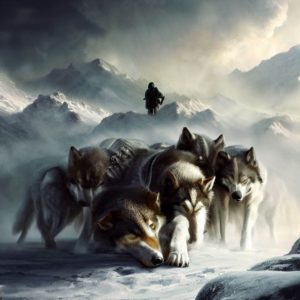“White Fang” (1991), adapted from Jack London’s classic novel, stands as a poignant testament to the power of resilience, the beauty of the wild, and the unbreakable bonds between man and animal. This article delves into the depths of “White Fang,” exploring how this film not only captures the essence of adventure and survival but also weaves a profound narrative about companionship, loyalty, and the journey towards finding one’s place in the world.
Journey into the Wilderness: The Setting of ‘White Fang’
“White Fang” transports its audience to the breathtaking, yet unforgiving landscapes of the Alaskan wilderness. Set during the Klondike Gold Rush, the film masterfully captures the era’s raw spirit and the relentless quest for survival and fortune. This backdrop serves as more than just a setting; it’s a character in its own right, shaping the story’s events and the characters’ journeys.
A Tale of Two Worlds: The Dual Narrative of White Fang
At its heart, “White Fang” is a story told in two halves. The first follows the titular character, a wolf-dog hybrid, as he navigates the challenges of the wild and learns the harsh realities of nature. The second half of the film sees White Fang encountering humans, leading to a poignant exploration of the bond that develops between him and Jack Conroy, a young prospector played by Ethan Hawke. This dual narrative structure allows the film to explore themes of survival, adaptation, and the clash between the wild and the civilized world.
The Bond of Loyalty and Trust: The Human-Animal Connection
The relationship between Jack and White Fang lies at the film’s emotional core. It’s a journey of mutual trust, respect, and understanding, transcending the boundaries of species. This bond is portrayed with sincerity and depth, highlighting the film’s central message: the power of kindness and empathy in taming the wildest of hearts and bridging the gap between worlds.
The Challenges of Adaptation: Staying True to London’s Vision
Adapting a beloved literary work like “White Fang” is no small feat. The film strikes a balance between staying faithful to Jack London’s vision and bringing its own unique interpretation to the screen. While certain liberties are taken for cinematic purposes, the essence of London’s narrative – the exploration of nature, the human condition, and the moral dilemmas faced by both man and beast – is adeptly preserved.
Legacy and Impact: ‘White Fang’s’ Place in Cinematic History
Since its release, “White Fang” has secured a special place in the hearts of its audience, becoming a beloved classic in the genre of adventure and animal films. Its impact lies not just in its storytelling but in how it presents its animal characters – not as mere beasts, but as beings with emotions, intelligence, and a spirit of their own. The film opened doors for more nuanced and empathetic portrayals of animals in cinema, influencing a generation of filmmakers and animal lovers alike.
The Timeless Call of ‘White Fang’
In conclusion, “White Fang” is more than just a film; it is a celebration of the indomitable spirit of survival, the beauty of the untamed wilderness, and the profound connections that can form between man and animal. Its legacy is a reminder of the power of empathy, the importance of resilience, and the timeless call of the wild that echoes in the heart of every viewer, inspiring a deeper appreciation for the natural world and the creatures that inhabit it.








